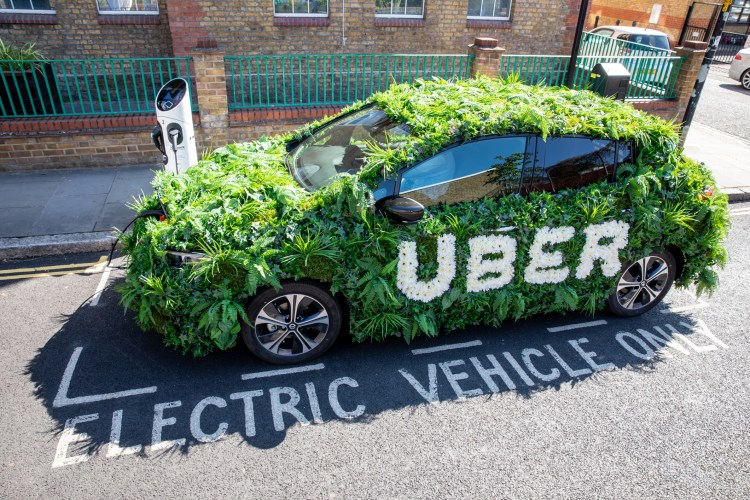Watch all the Transform 2020 sessions on-demand here.
Hot on the heels of Lyft’s public market debut, Uber filed its S-1 today with the U.S. Securities and Exchange Commission, setting the stage for its initial public offering next month. It’s chock full of interesting tidbits (like Uber’s ticker symbol, “UBER”), but one section that stands out is a progress report on its ongoing autonomous vehicle initiatives.
Uber notes that its Advanced Technologies Group (ATG) — the group heading up development of its driverless solutions — has grown from a team of 40 Pittsburgh-based researchers in 2015 to a 1,000-person workforce spread across offices in San Francisco and elsewhere. It incurred $457 million of research and development expenses in 2018, a year after Uber opened an ATG unit in Toronto and said it would invest more than $150 million to grow its self-driving car and AI operations there. (That’s up from $384 million in 2017 and $230 million in 2016.) And Uber revealed that it’s collected data from “millions” of autonomous vehicle testing miles to date and completed “tens of thousands” of passenger trips with a fleet of 250 vehicles.
Looking ahead, Uber expects that cars like those it’s currently testing will replace drivers in some situations, but not right away. Instead, it’s predicting a “long period of hybrid autonomy” in which autonomous vehicles are deployed “gradually” against specific use cases — for instance, in scenarios involving substantial traffic, complex routes, or unusual weather or during “high-demand events” such as concerts or sporting events.
Uber isn’t naive — it concedes that its investments in autonomous vehicles may “add to driver dissatisfaction over time” — but it says that it expects that drivers will “[remain a] critical and differentiating [market] advantage” for it and continue to be “valued partners” for the long term. That said, Uber also predicts that autonomous vehicles will “substantially” reduce the cost of providing ridesharing, meal delivery, or logistics services.
June 5th: The AI Audit in NYC
Join us next week in NYC to engage with top executive leaders, delving into strategies for auditing AI models to ensure fairness, optimal performance, and ethical compliance across diverse organizations. Secure your attendance for this exclusive invite-only event.
Uber has a mixed track record when it comes to self-driving car research, to put it mildly. It restarted tests of its driverless cars in Pittsburgh last December, eight months after one of its prototype Volvo SUVs struck and killed a pedestrian in Tempe, Arizona, and began manual tests in San Francisco and Toronto.
This summer, the National Transportation Safety Board (NTSB) determined that Uber engineers had disabled the automatic emergency braking system in the Volvo XC90 involved in the accident. (In internal documents, the company said this was to “reduce the potential for erratic vehicle behavior.”) The NTSB also found that the car’s perception system detected the victim about six seconds before impact but that it didn’t determine emergency braking was needed until 1.3 seconds before impact.
Following the crash, Uber halted self-driving tests across the country and laid off 100 of its autonomous vehicle operators.
In a voluntary safety assessment filed with the NTSB, Uber said that with a newly established systems engineering testing team it’s now better positioned “to reason over many possible outcomes to ultimately come to a safe response,” and that it intends to form a self-driving safety advisory board of outside experts. It also said that it spent months testing its self-driving technology on a closed track and completed a lengthy internal review, and that it hired an advisor — former National Transportation Safety Board (NTSB) chair Christopher Hart — to assess its safety culture.
In a blog post published in June, head of ATG Eric Meyhofer detailed newly implemented safeguards, such as a training program focused on safe manual driving and monitoring systems that alert remote monitors if drivers take their eyes off the road. It now mandates that teams of two employees — “mission specialists” — drive its cars, switching off every two hours. And in Pittsburgh, Uber says that those cars operate on a mile-long route between two of its offices in the city’s Strip District and travel no faster than 25 miles per hour, and stay off of the roads at night and during inclement weather.
The bumps in the road haven’t deterred investors. Earlier this year, Reuters reported that group led by SoftBank and Toyota is in talks to invest $1 billion or more into Uber’s self-driving vehicle unit, which would value the unit at $5 billion to $10 billion. It might have competition in spades — Waymo, Cruise Automation, Tesla, Apple, Zoox, Aptiv, May Mobility, Pronto.ai, Aurora, and Nuro, to name a few — but in a global market that’s forecast to hit revenue of $173.15 billion by 2023, there’s plenty of cash to go around.


